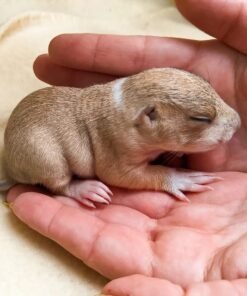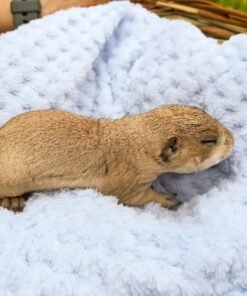PRAIRIE DOG
Prairie Dog: Detailed Overview
Scientific Classification:
- Scientific Name: Cynomys spp.
- Family: Sciuridae
General Description
Prairie dogs are burrowing rodents native to the grasslands of North America. These social animals live in large colonies or “towns” and are known for their complex social behaviors and communication systems. Prairie Dog
Physical Characteristics
- Size and Appearance
- Weight: Typically between 0.5 to 1.5 kilograms (1 to 3 pounds).
- Length: Body length ranges from 30 to 40 cm (12 to 16 inches), with a tail length of approximately 7 to 10 cm (3 to 4 inches).
- Fur: Short and dense, usually light brown to tan with lighter underbellies.
- Eyes: Large and positioned high on the head for a wide field of view to spot predators.
- Teeth: Sharp incisors that continuously grow, adapted for gnawing on vegetation.
Habitat
- Geographic Range: Native to the grasslands and prairies of North America, primarily found in the central and western United States, parts of Canada, and northern Mexico.
- Preferred Environment: Prefer open grasslands and prairies where they can dig extensive burrow systems.
Behavior and Lifestyle
- Activity Patterns
- Diurnal: Active during the day, particularly in the early morning and late afternoon. MALE PRAIRIE DOG FOR SALE
- Seasonal Activity: In colder regions, they may enter a state of torpor during the winter months but do not hibernate.
- Diet
- Herbivorous: Primarily eat grasses, roots, seeds, and leaves. They may occasionally consume insects.
- Social Structure
- Highly social animals living in large colonies known as “towns.”
- Family Groups: Colonies are divided into smaller family groups called “coteries,” consisting of one or two males, several females, and their offspring.
- Communication: Use a complex system of vocalizations to communicate, including alarm calls that vary to indicate different types of predators.
Reproduction
- Breeding
- Mating season occurs in early spring.
- Gestation Period: About 30 to 35 days.
- Litter Size: Females give birth to litters of 3 to 8 pups, typically once a year.
- Parental Care
- Pups are born blind and hairless and remain underground for the first 6 weeks of life.
- Mothers nurse and care for the pups until they are old enough to emerge from the burrow.
Adaptations
- Burrowing
- Dig extensive underground burrow systems with multiple entrances, chambers for nesting, and tunnels for escape from predators.
- Burrows provide protection from predators and extreme weather conditions.
- Communication
- Use a sophisticated system of vocalizations to warn colony members of danger.
- Each type of predator (e.g., hawk, coyote, human) has a distinct alarm call.
- Social Structure
- Strong social bonds within coteries help in cooperative defense and raising of young.
Conservation Status
- Threats
- Habitat loss due to agriculture and urban development.
- Poisoning and eradication programs due to their perception as pests by farmers and ranchers. FEMALE PRAIRIE DOG FOR SALE
- Disease, particularly sylvatic plague.
- Conservation Efforts
- Efforts include habitat restoration, legal protection, and reintroduction programs in some areas.
- Prairie dogs play a crucial role in their ecosystem, supporting biodiversity by providing habitat for other species.
Interesting Facts
- Ecosystem Engineers
- Prairie dogs are considered a keystone species; their burrowing activities aerate the soil and their presence supports a variety of other wildlife, including burrowing owls, black-footed ferrets, and numerous insect species.
- Communication Skills
- Prairie dogs have one of the most sophisticated vocal communication systems in the animal kingdom, with different calls for various predators and even descriptive elements about the threat (e.g., size, shape, speed).
- Impact on Vegetation
- Their grazing helps maintain the health of grasslands, preventing the overgrowth of certain plants and promoting a diverse plant community.
Conclusion
Prairie dogs are fascinating rodents with complex social structures, sophisticated communication systems, and significant ecological roles. Their burrowing activities and grazing habits make them essential for maintaining healthy grassland ecosystems. BUY FEMALE PRAIRIE DOG, Conservation efforts are crucial to protect prairie dog populations and the biodiversity of the habitats they support. Understanding their behavior, diet, and environmental needs helps in appreciating and preserving these remarkable



